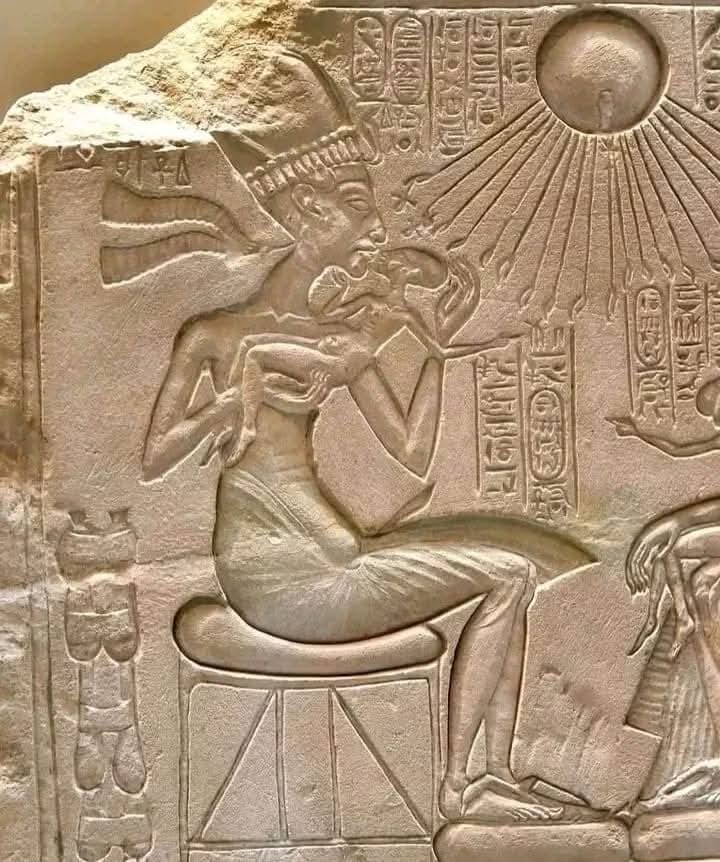This exquisite artifact, dated to approximately 1345 BCE during the New Kingdom’s 18th Dynasty, offers a rare and captivating glimpse into the life and reign of Pharaoh Akhenaten. Depicting Akhenaten alongside one of his daughters, this piece was unearthed in the ancient city of Amarna, Egypt. It serves as a hallmark of the groundbreaking Amarna art style, renowned for its departure from traditional Egyptian artistic conventions and its reflection of profound cultural and ideological shifts under Akhenaten’s reign.
The Unique Characteristics of Amarna Art
The Amarna art style stands out for its distinctive naturalism and intimate portrayals, breaking away from the rigid and idealized depictions of earlier dynasties. This artifact exemplifies these qualities, showcasing Akhenaten and his daughter with soft, elongated features and relaxed postures. The exaggerated cranial shapes, full lips, and slender limbs—all hallmarks of Amarna art—highlight an intentional effort to humanize the royal family. These artistic choices were revolutionary, offering a new perspective on how rulers and their families were depicted.

Amarna art also captured scenes of daily life with warmth and emotional depth. For instance, artifacts often depict Akhenaten interacting tenderly with his wife, Queen Nefertiti, and their children, all under the life-giving rays of Aten, the sun disk. The sun disk’s rays frequently culminate in hands bestowing blessings, a symbolic connection between the royal family and their divine patron. This blend of personal affection and divine symbolism defined the unique artistic approach of the Amarna period, reflecting a society in transition.
Religious and Cultural Significance
The Amarna art style cannot be separated from the religious revolution spearheaded by Akhenaten. Rejecting the long-standing polytheistic traditions of ancient Egypt, Akhenaten introduced a monotheistic worship system centered on Aten. This radical shift in religious ideology influenced every aspect of life, including art. Traditional depictions of gods and pharaohs as formal, distant entities were replaced with portrayals that emphasized their humanity and divine connection.
In this artifact, the bond between Akhenaten and his daughter is not merely a display of familial affection but a visual representation of the pharaoh’s role as a divine intermediary. The intimate nature of their depiction underscores Akhenaten’s theological reforms, which positioned the royal family as the central link between the earthly and celestial realms. This artifact thus serves as both a personal and theological narrative, encapsulating the transformative nature of Akhenaten’s reign.
Historical Context of the Artifact
The artifact originates from Amarna, a city established by Akhenaten to honor Aten and serve as the epicenter of his religious and cultural revolution. Amarna’s architecture and art reflect a deliberate break from traditional norms, embodying the pharaoh’s vision for a new cultural identity. This city, with its innovative designs and artistic experimentation, became a symbol of Akhenaten’s ambitious efforts to reshape Egyptian society.
Preserved for millennia, this artifact now resides in the Neues Museum in Berlin, Germany. Its survival offers invaluable insights into a pivotal period of Egyptian history characterized by experimentation and change. The piece provides a tangible connection to the ideological and artistic shifts that defined Akhenaten’s reign, offering modern audiences a window into the complexities of this transformative era.
Legacy and Modern Significance
The artifact’s significance extends beyond its historical and artistic value. It offers a rare glimpse into the private lives of Akhenaten’s royal family, highlighting the human aspects of a ruler often remembered for his revolutionary ideas. This intimate portrayal invites viewers to consider the intersection of personal relationships and divine authority in ancient Egyptian society.
For historians and art enthusiasts, the artifact remains a focal point for understanding the complexities of Akhenaten’s era. It underscores the profound impact of his artistic and religious reforms, which continue to captivate modern audiences with their depth and humanity. By examining this piece, we gain a deeper appreciation for the transformative power of art and its ability to communicate cultural shifts and personal narratives.
The legacy of Akhenaten’s reign and the Amarna art style endures, offering timeless lessons about innovation, identity, and the role of leadership in shaping cultural values. This artifact serves as a testament to the courage required to challenge established norms and embrace new ways of thinking. Its intimate depiction of Akhenaten and his daughter reminds us that even the most revolutionary leaders are shaped by their personal connections and beliefs.
Conclusion
The depiction of Akhenaten and his daughter is more than a mere artifact; it is a profound window into one of the most transformative periods of ancient Egyptian history. Housed in the Neues Museum, it stands as a symbol of the bold experimentation and personal expression that defined the Amarna period. Through this piece, we are invited to explore the rich tapestry of life, faith, and creativity in the ancient world.
As we reflect on this artifact, we are reminded of the enduring legacy of Akhenaten’s revolutionary vision. His reign challenged traditional norms and redefined the relationship between art, religion, and society. This intimate portrayal of Akhenaten with his daughter not only captures a moment in time but also invites us to consider the timeless questions of leadership, faith, and humanity. By preserving and studying this remarkable piece, we ensure that the lessons of the Amarna period continue to inspire and resonate across generations.





